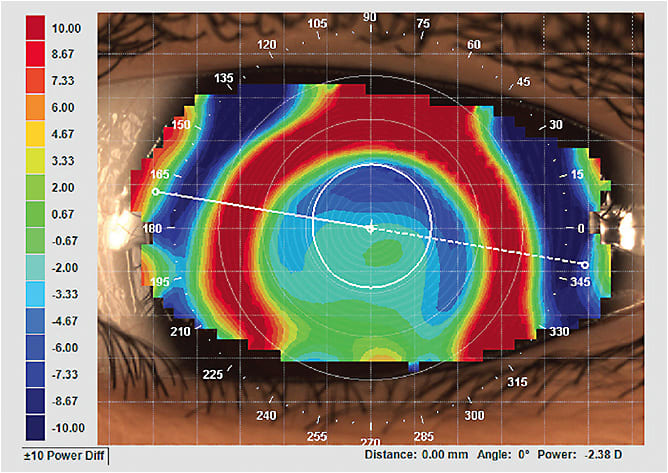ONE MISSION-CRITICAL aspect of orthokeratology (ortho-k) treatment is getting the lenses to center properly while the patient sleeps. Decentration of the treatment area can lead to irregular astigmatism and reduced visual acuity. Ortho-k lenses that look great in open-eye viewing don’t always perform as expected with the eyes closed. Fortunately, post-wear topography reveals where the lens positioned overnight, and eye-care practitioners can use it to make decisions about parameter changes.
CASE PRESENTATION
A recent case illustrates the decentration troubleshooting process. Figure 1 shows a post ortho-k topography. Uncorrected visual acuity after a week was 20/25, and the eye had picked up about 0.75DC of induced astigmatism. The patient complained of halos and mildly distorted vision.

The topography shows a mild “frowny-face” pattern, indicative of a lens that is riding too low while the patient is sleeping. The parameters were adjusted (discussed below) to get the lens to sit a little higher, and the result is shown in Figure 2: a well-centered treatment area (the red ring is aligned with the pupil).

ORTHO-K PARAMETERS
Ortho-k centration is influenced by three lens-related factors: lens diameter, reverse zone (RZ) curvature/sagittal height (sag), and alignment zone (AZ) curvature/sag. Horizontal decentration in an otherwise good fit can be helped by increasing the lens diameter. Inferior decentration (seen in a “frowny face” pattern) means the lens sag is too deep; superior decentration (“smiley face” pattern) means it’s too shallow.
Start by reevaluating the fluorescein pattern, looking first at the edge clearance; if excessive, the AZ is too flat, and vice versa. If the edge clearance and AZ look good, it’s likely the RZ sag that is incorrect. A too-steep reverse curve may have arc-shaped bubbles under it—or may look “muddy” without a clear bullseye appearance. A shallow reverse curve will often show some fluorescein leakage into the AZ area.
PARAMETER CHANGES
In this case, the mild “frowny face” speaks to the need to mildly decrease the sag depth. The lens fit looked acceptable but with a slightly thin edge clearance, so I elected to flatten the AZ one step (about 10 microns in sag change). If this had not worked, I could have gone back to the original AZ and flattened the RZ instead for a larger change.
CONCLUSIONS
Ortho-k is a fun and challenging part of practice. Small changes in parameters can make big changes in how the lens alters the corneal shape. As always, discuss any fitting issues with your lab consultant, who can provide guidance on the lens parameters, for best results. CLS





